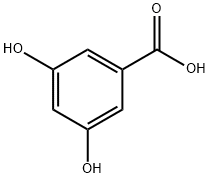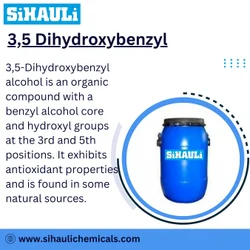3,5-Dihydroxybenzyl alcohol
Synonym(s):5-(Hydroxymethyl)resorcinol
- CAS NO.:29654-55-5
- Empirical Formula: C7H8O3
- Molecular Weight: 140.14
- MDL number: MFCD00016867
- EINECS: 249-751-8
- SAFETY DATA SHEET (SDS)
- Update Date: 2025-10-20 09:29:14

What is 3,5-Dihydroxybenzyl alcohol?
Chemical properties
White to light yellow crystal powder
The Uses of 3,5-Dihydroxybenzyl alcohol
3,5-Dihydroxybenzyl Alcohol is a used as a dendrimer building block.
The Uses of 3,5-Dihydroxybenzyl alcohol
3,5-Dihydroxybenzyl alcohol may be used as monomer for the synthesis of a series of monodisperse dendritic polyether macromolecules.?It may be employed in the synthesis of dimethylsilyl linked dihydroxybenzyl alcohol based dendrimers.
General Description
Aggregation behavior of 3,5-dihydroxybenzyl alcohol based dendritic polymers has been investigated by dynamic light scattering and transmission electron microscopy. Preparation of dendritic polyether macromolecules based on 3, 5-dihydroxybenzyl alcohol building block and having carboxylate groups as chain-ends has been described.
Properties of 3,5-Dihydroxybenzyl alcohol
| Melting point: | 182-186 °C (dec.) (lit.) |
| Boiling point: | 216.62°C (rough estimate) |
| Density | 1.2127 (rough estimate) |
| refractive index | 1.4638 (estimate) |
| storage temp. | Inert atmosphere,2-8°C |
| solubility | Soluble in DMSO, methanol. |
| form | Crystalline Powder |
| pka | 9.23±0.10(Predicted) |
| color | Off-white to beige-pink or gray |
| BRN | 2326351 |
| CAS DataBase Reference | 29654-55-5(CAS DataBase Reference) |
Safety information for 3,5-Dihydroxybenzyl alcohol
| Signal word | Warning |
| Pictogram(s) |
 Exclamation Mark Irritant GHS07 |
| GHS Hazard Statements |
H315:Skin corrosion/irritation H319:Serious eye damage/eye irritation H335:Specific target organ toxicity, single exposure;Respiratory tract irritation |
| Precautionary Statement Codes |
P261:Avoid breathing dust/fume/gas/mist/vapours/spray. P264:Wash hands thoroughly after handling. P264:Wash skin thouroughly after handling. P271:Use only outdoors or in a well-ventilated area. P280:Wear protective gloves/protective clothing/eye protection/face protection. P302+P352:IF ON SKIN: wash with plenty of soap and water. P305+P351+P338:IF IN EYES: Rinse cautiously with water for several minutes. Remove contact lenses, if present and easy to do. Continuerinsing. |
Computed Descriptors for 3,5-Dihydroxybenzyl alcohol
| InChIKey | NGYYFWGABVVEPL-UHFFFAOYSA-N |
3,5-Dihydroxybenzyl alcohol manufacturer
SAKEM LLP
1Y
Phone:+91-9676889998
Whatsapp: +91-9676889998
product: 29654-55-5 3,5-Dihydroxybenzylalcohol 98%
New Products
4,4-Difluoropiperidine hydrochloride tert-butyl 9-methoxy-3-azaspiro[5.5]undecane-3-carboxylate Indole Methyl Resin N-Isopropylurea N,N-Dicyclohexylcarbodiimide(DCC) MELDRUMS ACID 5-METHYLISOXAZOLE-4-CARBOXYLIC ACID Magnessium Bis glycinate Zinc ascorbate 1-bromo-2-butyne 2-acetamidophenol 9(10H)-anthracenone Erythrosin B, 4-Piperidinopiperidine 2-((4-morpholinophenylamino) (methylthio) methylene) malononitrile 2,4-dihydroxybenzaldehyde 3-(4-morpholinophenylamino)-5-amino-1H-pyrazole-4-carbonitrile Methyl 2-methylquinoline-6-carboxylate 2,6-dichloro-4-nitropyridine 4-Bromo-2-chlorobenzonitrile 2-(benzylamino)acetic acid hydrochloride 4-(tert-Butoxycarbonylamino)but- 2-ynoic acid 3,4-dihydro-2H-benzo[b][1,4]dioxepine 1-Phenyl-1-cycloprppanecarboxylicacidRelated products of tetrahydrofuran








You may like
-
 29654-55-5 3,5-Dihydroxybenzyl alcohol 98%View Details
29654-55-5 3,5-Dihydroxybenzyl alcohol 98%View Details
29654-55-5 -
 29654-55-5 99%View Details
29654-55-5 99%View Details
29654-55-5 -
 3,5-Dihydroxybenzyl Alcohol CAS 29654-55-5View Details
3,5-Dihydroxybenzyl Alcohol CAS 29654-55-5View Details
29654-55-5 -
 3,5-Dihydroxybenzyl alcohol CAS 29654-55-5View Details
3,5-Dihydroxybenzyl alcohol CAS 29654-55-5View Details
29654-55-5 -
 3,5 Dihydroxybenzyl AlcoholView Details
3,5 Dihydroxybenzyl AlcoholView Details
29654-55-5 -
 pcchem Chemical Grade 3,5-Dihydroxybenzyl Alcohol, Packaging Type: 1kgView Details
pcchem Chemical Grade 3,5-Dihydroxybenzyl Alcohol, Packaging Type: 1kgView Details
29654-55-5 -
 29654-55-5 3,5-Dihydroxybenzylalcohol 98%View Details
29654-55-5 3,5-Dihydroxybenzylalcohol 98%View Details
29654-55-5 -
 20677-73-0 (2,2-diethoxyethyl)methylamine 98%View Details
20677-73-0 (2,2-diethoxyethyl)methylamine 98%View Details
20677-73-0
Statement: All products displayed on this website are only used for non medical purposes such as industrial applications or scientific research, and cannot be used for clinical diagnosis or treatment of humans or animals. They are not medicinal or edible.
